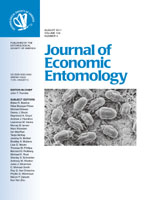Pollination services of pumpkin, Cucurbita pepo L., provided by the European honey bee, Apis mellifera L., were compared with two native bee species, the common eastern bumble bee, Bombus impatiens (Cresson), and Peponapis pruinosa Say, in New York from 2008 to 2010. Performance of each species was determined by comparing single-visit pollen deposition, percentage of visits that contacted the stigma, flower-handling time, fruit and seed set, and fruit weight per number of visits. Fruit yield from small fields (0.6 ha) supplemented with commercial B. impatiens colonies was compared with yield from those not supplemented. A. mellifera spent nearly 2 and 3 times longer foraging on each pistillate flower compared with B. impatiens and P. pruinosa, respectively. A. mellifera also visited pistillate flowers 10–20 times more frequently than B. impatiens and P. pruinosa, respectively. Yet, B. impatiens deposited 3 times more pollen grains per stigma and contacted stigmas significantly more often than either A. mellifera or P. pruinosa. Fruit set and weight from flowers visited four to eight times by B. impatiens were similar to those from open-pollinated flowers, whereas flowers pollinated by A. mellifera and P. pruinosa produced fewer fruit and smaller fruit compared with those from open-pollinated flowers. Fields supplemented with B. impatiens produced significantly more pumpkins per plant than nonsupplemented fields. B. impatiens was a better pollinator of pumpkin than P. pruinosa and should be considered as a promising alternative to A. mellifera for pollinating this crop.
How to translate text using browser tools
1 August 2011
Performance of Apis mellifera, Bombus impatiens, and Peponapis pruinosa (Hymenoptera: Apidae) as Pollinators of Pumpkin
Derek R. Artz,
Brian A. Nault
ACCESS THE FULL ARTICLE
It is not available for individual sale.
This article is only available to subscribers.
It is not available for individual sale.
It is not available for individual sale.

Journal of Economic Entomology
Vol. 104 • No. 4
August 2011
Vol. 104 • No. 4
August 2011
common eastern bumble bee
European honey bee
foraging behavior
P. pruinosa
pumpkin




